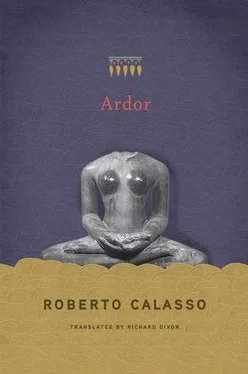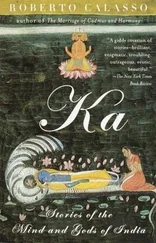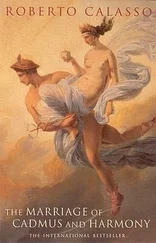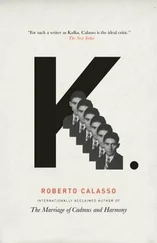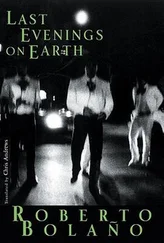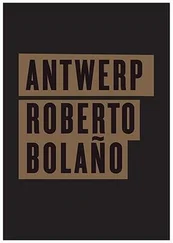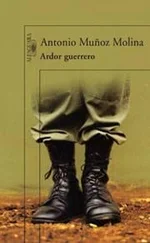Was the prohibition on putting certain questions an attempt to protect a particular sphere of knowledge, without being under any obligation to explain it? If that were so, it would have been no more than a trite priestly strategy of a kind that all future Voltaires would have readily mocked. But that wasn’t the case. As can be seen in another clash between Gārgī and Yājñavalkya.
Gārgī, in addition to being a theologian, was also a weaver. She felt that metaphysics should be perceivable in her art as in everything else. This was why she preferred to put questions connected with her trade: it was what she knew best. So, on two occasions, she asked Yājñavalkya for explanations about the “weft” used to weave a certain thing. Since she had once been spurned for her question — and threatened with a horrible death — one might have expected Gārgī to choose a different route. Instead she spoke once again about “weft.” But changing the way in which she put it (and perhaps this was the point: the prohibition was not on a certain question, but on a certain way of putting it). It shouldn’t be thought, however, that Gārgī’s manner this time was any milder or more obsequious. On the contrary — Gārgī announced straightaway that she would speak “like a warrior from the land of the Kāśi or the Videha, who comes forth holding two arrows ready to shoot the adversary.” But the formulation of her question had changed. This time it was Kantian. Gārgī asked first with what weft time (“that which is called past, present, future”) was woven. Yājñavalkya answered: “with the weft of space ( ākāśa ).” But Gārgī still had her second and last question in reserve: “With what weft is space woven?” At this point Gārgī might have been expecting a blunt refusal to answer, as on the previous occasion, together with the threat of death. This didn’t happen. Indeed, Yājñavalkya’s answer was immediate and expansive. He said that the weft of space was woven on the “indestructible” ( akṣara ). And he embarked on a lofty, intense, poetic explanation about akṣara. Anyone, he said, who doesn’t know it, whatever merits he has gained from good works — from sacrifices or abstinence — will remain “miserable.” Many centuries — almost thirty — were to go by before that “indestructible” would again be described with similar authority, in the aphorisms that Kafka wrote at Zürau between September 1917 and April 1918. Kafka was shorter, more succinct than Yājñavalkya, perhaps because he too feared his head might burst at any moment. But the purpose of their words was exactly the same.
Questioned by Gārgī, Yājñavalkya defined the “indestructible” through what it was not, as the whole succession of great mystics would later do. And he added a detail to be found nowhere else: the indestructible “eats nothing and no one eats it.” Here spoke the voice of the adhvaryu , that officiant who constantly carries out the necessary acts during the sacrifice. And that is exactly what Yājñavalkya was. For the expert on sacrifice, the chain of Agni and Soma, of the devourer and the devoured, is essential in defining what belongs to this world and what does not. Only what is not a part of that chain can be said to be beyond —and beyond that we cannot go.
* * *
Yājñavalkya’s discourse went a little further, continually interspersed with Gārgī’s name, as if the brahmin wanted to keep a tight hold on the weaver’s attention. He was, indeed, about to reach the crucial point: people are proud of seeing, of hearing, of perceiving, of knowing. They firmly believe they are made of all this. And now Yājñavalkya spoke of “this indestructible, O Gārgī, that is not seen and sees, not heard and hears, not thought and thinks, not known and knows.” And at the same time “it is the only one that sees, the only one that hears, the only one that thinks, the only one that knows.” People, whatever they do, are therefore passive, acted upon by an entity they may not even recognize. And, if they ever become aware of it and turn toward what is acting in them, they are obliged to realize that they cannot know it. And yet only “he who does not leave this world without having known this indestructible” can be considered a brahmin. But how can we know something that doesn’t let itself be known? In only one way: by becoming to some extent that thing itself.
The weft of that which is, of that space with which even ungraspable time is woven, is made of this, said Yājñavalkya. And that weft is indestructible. That weft is the indestructible, akṣara. Gārgī then turned to the other brahmins who were listening and told them, with ill-concealed insolence, that they ought to feel satisfied. She then added that no one would ever beat Yājñavalkya in a brahmodya.
* * *
The Śatapatha Brāhmaṇa is impressive in its length, venerable for its antiquity, and has been assiduously studied and plundered by scholars, who should have been persuaded to give it the prime consideration that every work deserves: to be viewed as one work — above all in its form. This hasn’t happened. There is, even now, no complete edition of the Śatapatha Brāhmaṇa , since it ought to include the Bṛhadāraṇyaka Upaniṣad as its final part. In December 1899, having reached the end of his magnificent enterprise of translating the Śatapatha Brāhmaṇa , which had taken him twenty years, Julius Eggeling calmly noted: “The present volume completes the theoretic exposition of the sacrificial ceremonial, and thus brings us to the end of our task. The remaining six chapters of the last book of the Brāhmaṇa form the so-called Bṛhadāraṇyaka , or great forest treatise, which, as one of the ten primitive Upaniṣads, is included in Professor F. Max Müller’s translation of those old theosophical treatises, published in the present series.” It was a candid way of announcing that one part of the Śatapatha Brāhmaṇa had been lopped off. And on various occasions thereafter, this missing part — one of the most famous texts of Indian thought — would be translated and annotated either alone or with other Upaniṣads.
The philological choice was very odd, as if Plato’s Republic had continued to circulate without its tenth book, which contains the story of Er the Pamphylian, who, twelve days after his death, “was already lying on the funeral pyre, when he came to life again and told the story of what he had seen in the other world” with descriptions that, from then on, became embedded in Western thought. Or as if, remaining on Indian soil, the Mahābhārata had been published without the Bhagavad Gītā.
The Śatapatha Brāhmaṇa , in the Eggeling edition, does not therefore contain the “hundred paths”—the hundred “lessons,” adhyāyas , to which the title refers — but only ninety-four of them. To read the last six we have to continue on with the Bṛhadāraṇyaka Upaniṣad. And there is a further twist: not only has the amputation of the text become accepted, but an entirely baseless theory has developed over many years about the existence of a radical contradiction between the early Upaniṣads and the Brāhmaṇas, coinciding with a revolt by the “princes” (the kṣatriyas , according to Renou’s translation) against the mean brahmins, who were superstitiously devoted to ritual. And it has therefore been decided, with supreme scholarly arrogance, to ignore the declaration in the Śatapatha Brāhmaṇa itself, at the end of its final part, that this is the work of one of those brahmins: Yājñavalkya. To be unequivocally recognized as the author of and character in both the Brāhmaṇa and the subsequent Upaniṣad, Yājñavalkya had to wait for the brilliant article by Louis Renou: “Les Relations du Śatapathabrāhmaṇa avec la Bṛhadāraṇyakopaniṣad et la personnalité de Yājñavalkya.” Published in 1948 in Indian Culture , a journal with a limited circulation and dotted with numerous Vedic acronyms and abbreviations as well as copious philological discussions, that study can be found today, all by itself, in the second volume of Renou’s Choix d’études indiennes. A crucial issue — the recomposition of the first clearly recognizable author to appear in Vedic India — continues thus to remain in philology’s protective shadow. And yet no one could be as worthy as Yājñavalkya to stand as a Vedic counterpoint and counterpart to the Buddha.
Читать дальше
